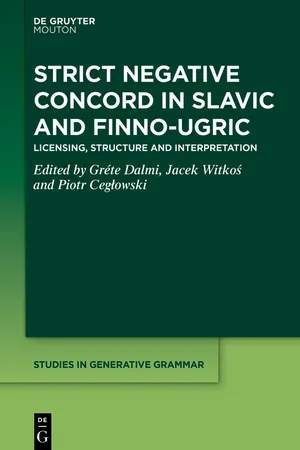
Strict Negative Concord in Slavic and Finno-Ugric
Licensing, Structure and Interpretation
- 324 pages
- English
- ePUB (mobile friendly)
- Available on iOS & Android
Strict Negative Concord in Slavic and Finno-Ugric
Licensing, Structure and Interpretation
About this book
Expressing negation is a universal property of all human languages. There is considerable variation, however, in the exact ways negation materializes cross-linguistically. Strict Negative Concord differs both from the Negative Polarity Item strategy and the Asymmetric Negative Concord strategy in that the sentence becomes negative only if the sentence negator is overtly expressed in it, irrespective of how many negative expressions are used.
The central aim of this book is to describe Strict Negative Concord in some Slavic and Finno-Ugric languages. In particular, the volume gives an insight into the forms Strict Negative Concord manifests itself in Russian, Polish, Czech, Slovenian (Slavic), Finnish, Hungarian, Mari (Finno-Ugric) and the closely related Selkup (Samoyedic) to a wide linguistic community. It aims to create a platform for comparison with similar phenomena in well-described European languages.
Frequently asked questions
- Essential is ideal for learners and professionals who enjoy exploring a wide range of subjects. Access the Essential Library with 800,000+ trusted titles and best-sellers across business, personal growth, and the humanities. Includes unlimited reading time and Standard Read Aloud voice.
- Complete: Perfect for advanced learners and researchers needing full, unrestricted access. Unlock 1.4M+ books across hundreds of subjects, including academic and specialized titles. The Complete Plan also includes advanced features like Premium Read Aloud and Research Assistant.
Please note we cannot support devices running on iOS 13 and Android 7 or earlier. Learn more about using the app.
Information
Table of contents
- Title Page
- Copyright
- Contents
- List of abbreviations
- 1 Slavic and Finno-Ugric in the typology of Negative Concord languages
- 2 Negative Concord in East Slavic: Looking into the core of the Bagel Problem
- 3 What ellipsis teaches us about Negative Concord
- 4 Neg-words and NPI’s in Czech
- 5 Negation and Negative Concord in Slovenian
- 6 Negative indefinites, Clausal Negation and Strict Negative Concord in Vepsian: Oscillating between Finnic and Russian
- 7 Licensing negative indefinites in Hungarian: A purely cartographic approach
- 8 Negative Concord in Mari
- 9 Negative Concord in Selkup: An overview
- 10 Strict Negative Concord in Slavic and Finno-Ugric: Concluding remarks
- Index